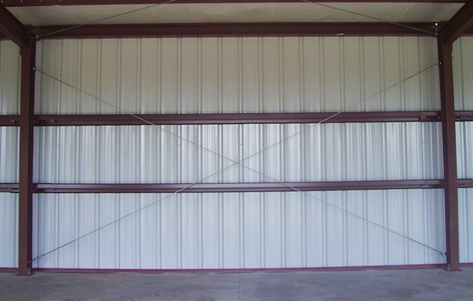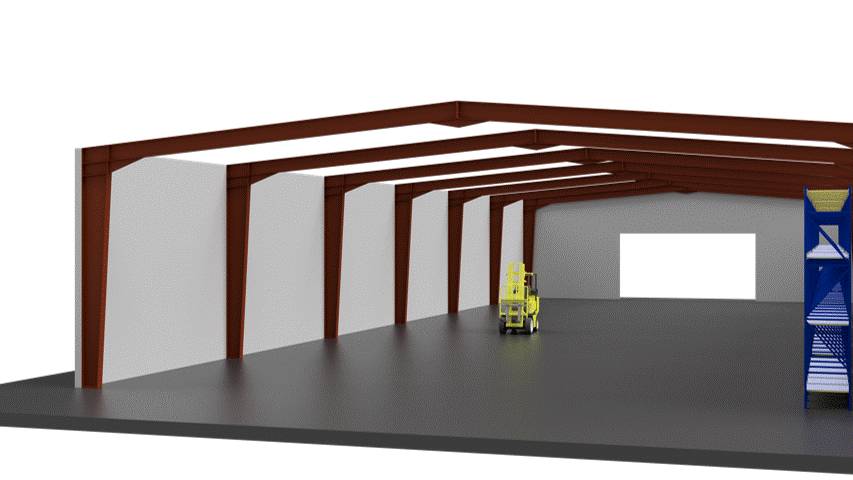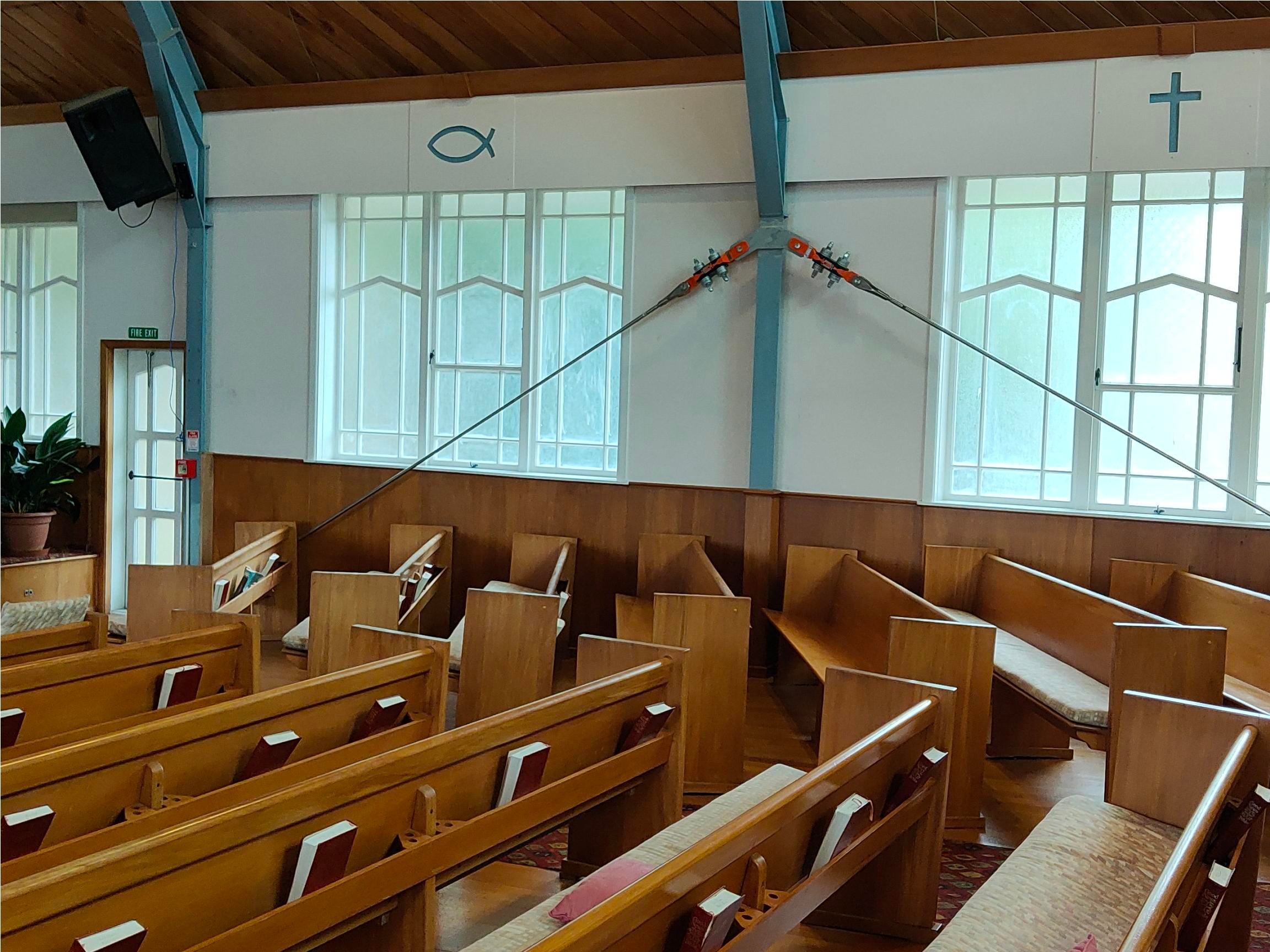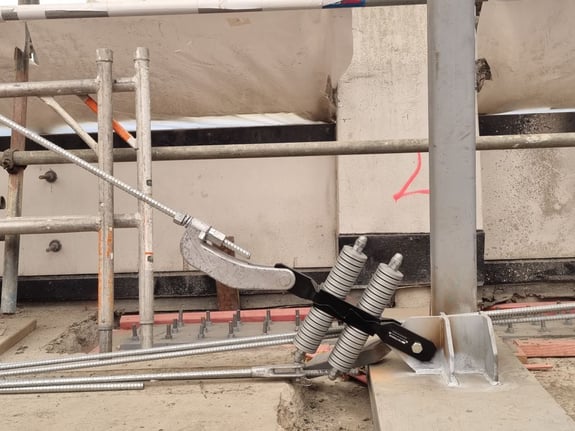Tension-only braces are a cost-effective alternative to traditional steel bracing. However, for buildings in earthquake-prone regions with high seismic demands, their efficiency is limited, since they are a non-ductile solution with no capacity to reduce the earthquake forces. Therefore, their applicability is limited to smaller buildings with lower seismic loads.
The addition of Tectonus devices greatly increases the seismic capacity of tension-only braces, making them a viable option for larger structures such as light industrial and commercial buildings. In retrofit applications, they can be a cost-effective way to introduce controlled ductility thereby saving the need for costly upgrades to structural members and foundations.
What are tension-only braces?
Tension-only braces, also known as tension-only members or tension-only elements, are structural components used in civil and structural engineering to resist axial forces in tension. They are commonly employed in buildings to provide stability and resist lateral forces such as wind or seismic loads.

Tension-only braces are common in single-storey steel frame buildings like this one.
The primary purpose of tension-only braces is to prevent the structure from swaying or deforming excessively under lateral loads. These braces work by transferring the applied lateral loads, such as wind or earthquake forces, into tension forces within the brace itself. In essence, they "pull" on the structure to counteract the pushing or lateral forces acting on it.
Tension-only bracing is particularly common in low-rise and light-industrial buildings. It is usually very cost-effective since it utilizes steel in its most efficient structural mode - tension. The bracing members are often slender, such as steel rods or flats, so their compressive strengths are negligible. Depending on the building weight and the number of braced frames bracing member cross-section diameters can be as little as 20 to 30 mm. The advantage of this type of bracing from an architectural perspective is its economy and transparency.
Main suppliers of tension-only bracing include ReidBrace, Donobrace, Anzor and Macalloy.
Seismic capacity of tension-only braces
Tension-only braces are useful in earthquake-prone regions because they allow a structure to dissipate seismic energy and reduce lateral drift and deformation during an earthquake.
Tension-only braces are typically slender and are susceptible to buckling under axial compression loads. Buckling can reduce their capacity to resist compression forces during an earthquake, potentially leading to failure.
Ductility is the ability of a structural element to deform and absorb energy during a seismic event. Tension-only braces do not possess the same level of ductility as other seismic-resistant systems, such as conventional steel bracing or special moment frames. As such, they are considered non-ductile or limited-ductility solutions. This can make it challenging to achieve the desired level of energy dissipation and deformation capacity in a seismic design.
The seismic capacity of a tension-only brace is primarily limited by the thickness of the brace. Since part of the attraction of tension-only braces is their slenderness, and because they offer no resistance in compression, at a certain point conventional steel bracing becomes a better option.
Tectonus tension-only braces
Combining Tectonus devices with tension-only braces greatly increases the seismic capacity of the system, making it a viable option for higher loads and therefore larger buildings.
The ductility of a tension-only brace is typically 1. It can be increased to 3 when paired with Tectonus devices. For example, a 25mm thick tension-only rod combined with a 200kN Tectonus device is able to deal with comparable loads of up to 600kN in case of using the rod only with no ductility. This means reducing the seismic demand by up to 3 times (depending on the structure's natural frequency).
The load paths are reliable and repeatable giving increased control to the designer.
Whilst seismic capacity is greatly increased, the system retains the overall advantages of slenderness, ease of installation and cost-effectiveness.
Application
The Tectonus tension-only brace system has been used in both new build and retrofit.
Warehouses
It is ideally suited for lighter-weight steel structures such as warehouses where the cross braces can be connected to steel members as shown below.

Retrofit
In retrofit applications, it can be an extremely cost-effective way to add ductility without increasing seismic demand on surrounding members or foundations.

Tectonus tension-only braces used in a church retrofit in Tawa, New Zealand
Tectonus devices have been installed with cost-effective ReidBrace and Anzor bars. Shortly we'll be doing a shaketable test using Donobrace, and they can also be applied on high-tensile Macalloy bars.
Performance testing
A Tectonus tension-only cable brace system was tested dynamically at the University of Auckland Structures Lab and the seismic performance was well demonstrated.
A 5 x 4 m bay frame was pushed to 5% drift, imposing 150 mm of deformation in the two 250kN Tectonus RSFJs of each brace (75 mm each), up to 0.2 Hz. This was achieved without any damage or residual drift.
A full write-up of the tests is available in the following paper.
Design
For typical light industrial and commercial buildings where the inelasticity is more or less localized in the Tectonus devices, a simple SLAMA exercise can demonstrate the performance of the system.
Given that these structures normally represent a single degree of freedom system with decent mass participation for the first translational mode, the analysis can be done using the pushover methods described in Part C2 of the MBIE ‘Red Book’ or ASCE 41 and FEMA 440.
The connection is simple being pin to pin at both ends.
Find out more
If you have a project at concept stage or later on in the process, we'd welcome the opportunity to discuss whether Tectonus + tension-only bracing could be a fit. Our in-house engineering team are here to help with design, modelling and analysis.
Contact us now for a free consultation.
